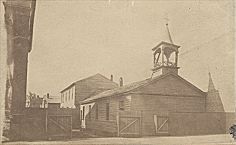| Entries |
| B |
|
Balloon Frame Construction
|

|
During the colonial period, carpenters simplified the timber frame to allow for rapid construction with standardized materials. The Beaubien Tavern on the plank road between Chicago and Naperville, in what is now Lisle, reflected these changes. The frame employed smaller, standardized timbers. All mortises and tenons were very simple. The roof was a system of small common rafters held in place by nails. Joinery did not attach it intimately to the frame. Heated by stoves, the building had no need for a large, central fireplace.
A minimal difference existed between the tavern's box frame and early balloon frames. Timber girts supported the tavern's second-story floor joists. They were tenoned, pinned, and braced to mortised corner posts. The balloon frame eliminated these elements by nailing a one-by-four-inch board, called a ledger or ribband, into vertical studs that ran continuously to the height of the building. The studs were notched to accommodate the ledger. The second-floor joists were also notched and then hooked onto the ledger. The joists were then nailed to the studs.
The idea was not original. Carpenters in seventeenth-century Virginia employed a similar method when confronted with pressures to build rapidly. But no matter the type of frame, carpenters could not reduce substantially the handwork necessary for building a house until the 1880s. Then, Chicago carpenters replaced mortised-and-tenoned timber sills with box sills that used only dimensional lumber joined by nails. By this time, factories produced most windows, doors, and trim, as well as kiln-dried dimensional lumber with tighter tolerances. Carpenters on the site merely fit and installed these products.
The balloon frame evolved slowly over the course of the nineteenth century. It resulted from modest shifts in the practice of many carpenters over time. Most likely, Chicago gained a reputation for the invention owing to factories like the Lyman Bridges Company that produced ready-made houses with balloon frames that were sold to various Western cities attempting to meet the needs of rapidly expanding populations.
The Encyclopedia of Chicago © 2004 The Newberry Library. All Rights Reserved. Portions are copyrighted by other institutions and individuals. Additional information on copyright and permissions.